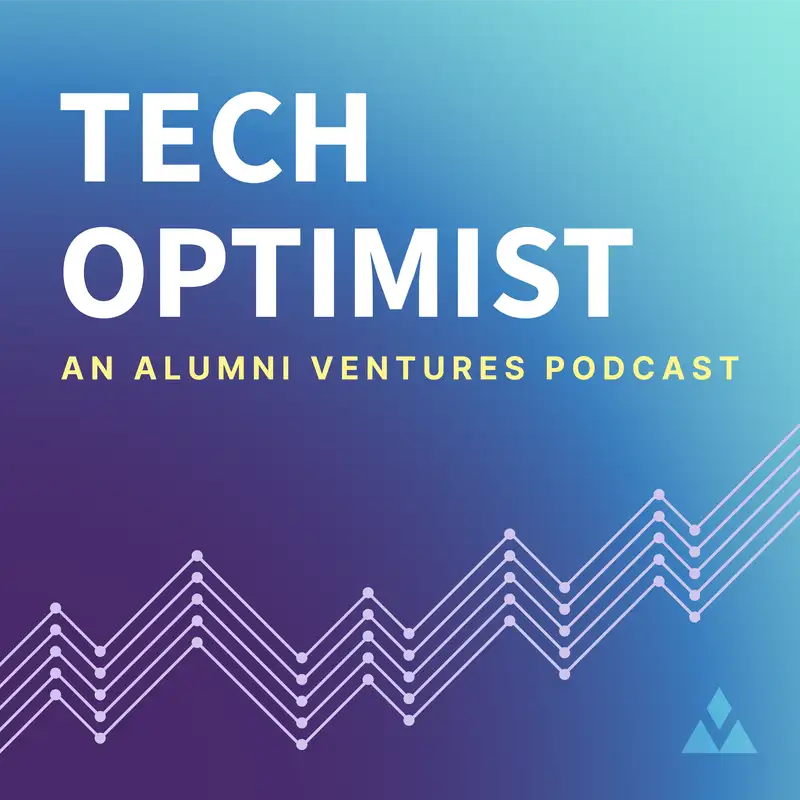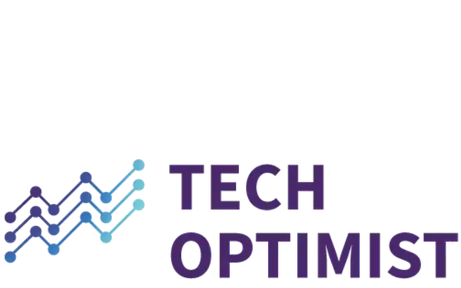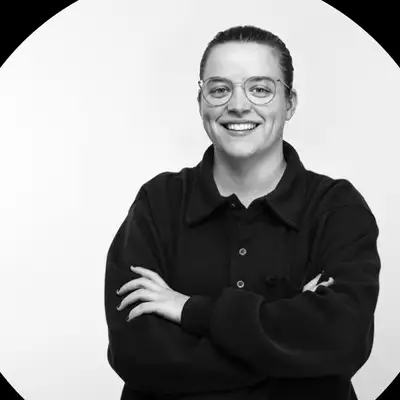#39 - Meet the Startup Unifying the Digital & Physical Worlds
Samantha Herrick:
Today's company has helped bring the Disney theme parks to life. Want to find out how? Listen in.
Kirin Sinha:
Really about how can we be the operating system and create that level of intelligence, personalization in physical space.
Laura Rippy:
That ability to see from different schools, pull it together as you have that is the prescience that enables you to see new market opportunities and build a business that has not been created before.
Kirin Sinha:
To me, that was my hair on fire moment of this is going to change the world. If we look at the way this is going, I know digital and physical are going to intersect.
Samantha Herrick:
Welcome back to the Tech Optimist, everyone. Today, is a Meet the Startup episode featuring Illumix. We have another first time guest and host today. Today's episode is going to be brought us through by Laura Rippy, a managing partner and board member at Alumni Ventures. And then our guest today is the founder and CEO of Illumix, Kirin Sinha. And then of course, I will be here to guide you along the episode, Sam Herrick, your guide, your narrative savant. Let's do it again.
In a world captivated by criticism, it's easy to overlook the groundbreaking technologies shaping our future. Let's a light on innovators who are propelling us forward. As the most active venture capital firm in the US, we have an exceptional view of tech's real world impact. Join us as we explore, celebrate, and contribute to the stories of those creating tomorrow. Welcome to the Tech Optimist.
As a reminder, the Tech Optimist podcast is for the informational purposes only. It is not personalized advice and it's not an offer to buy or sell securities. For additional important details, please see the text description accompanying this episode.
Laura Rippy:
Hi, everyone. It's Laura Rippy. I am managing partner at Alumni Ventures and thrilled to be here with Kirin Sinha, who is the CEO of Illumix. Illumix is a software platform company in the augmented reality space. Kirin, share with us what does Illumix do and what do all those big words mean?
Kirin Sinha:
Sure. So let's start with what is augmented reality? For those of you that are jumping into this space for the first time, you've probably heard AR/VR. But just to separate the two, augmented reality is when digital objects are in your physical space. So think Pokemon Go of, we have now Pokemon all over our real world. Something like VR tends to be when you are in a digital space. So wow, when I look around, it looks like I'm on Mars, but it's all digitally created, right?
So that's the kind of key distinction you look for. We operate in augmented reality, which means we're bringing digital to our real world. And specifically what Illumix does is we partner with large enterprises with physical spaces. So think anything from theme parks to music festivals, sports stadiums, malls, any physical presence to add digital items and elements into their space.
And this might be about personalizing something for you. This might be about helping you find your seat in a stadium. This might be helping to prod you when it's the right time to go and get some merch or get those fries because there's a smaller line. It's really about how can we be the operating system and create that level of intelligence personalization in physical space.
Laura Rippy:
Fascinating. That is amazing. So your customers are venues like music venues, like theme parks like sports. And for those big brands that want to bring the digital into that physical space and connect with that next generation of customer, that's the difficult platform that y'all have built and are building at Illumix. That's amazing.
Samantha Herrick:
So like Kirin was explaining here, on their website, they have a really good representation of what their product is and another entertainment tab. They have a few notes on here that I really want to share, but if you want to see these for yourself, hop over to www.illumix.com/product/entertainment. But anyway, so they have some really cool sort of catchphrases here. We are in a digital revolution. The physical and digital worlds are coming together to create new experiences, opportunities and ways to engage. 73% of all users want augmented reality as part of their entertainment experience.
Illumix is a leading enterprise level AR platform, attract top global brands with a superior guest experience powered by Illumix. Over 40 million app downloads have been generated for brands using Illumix. Enhance the guest experience to drive high revenues. Put guest signature with digital physical experiences. Extend the experience beyond just the venue by capturing the full journey.
400 million plus AR interactions powered through the Illumix platform. And it's really cool. I again, am not an augmented reality specialist, I'm not a virtual reality designer, but their package or their product is like a template. So they provide the complete package of infrastructure, products and tools to get started with immersing and engaging your audience. So they are an excellent company to utilize.
If your space or your public venue space or your company, your sales company really wants to take that next step into that our ever-growing sort of digital world. All right. We're going to do our first ad break. We're going to hop right back into the interview with Laura and Kirin. Don't go anywhere.
Laura Rippy:
Hey, everyone. Taking a quick break to share more about the Women's Fund from Alumni Ventures. AV is one of the only VC firms focused on making venture capital accessible to individual accredited investors like you. In fact, AV is one of the most active and best performing VCs in the US and we co-invest alongside renowned lead investors. With the Alumni Ventures Women's Fund, you'll have the opportunity to help us invest in fiery female founders.
PitchBook reports, female-led startups are more capital efficient and exit faster, yet only receive 15% of all venture capital dollars. We see this as a great opportunity and we're starting from a position of strength. Alumni Ventures has already invested in over 350 startups founded, co-founded or led by women. So join us in the Alumni Ventures Women's Fund to put your investing capital to back a diversified portfolio of female-led high-velocity startups as they change the world. Visit av.vc.funds/womens to learn more. Now, back to the show.
Love what you guys are doing. Let's step back a little bit. What's your founder story, Kirin?
Kirin Sinha:
Well, in case it wasn't obvious from that bit, I have been a nerd for my entire life. I always thought I was going to be a math professor, so that's what I was gung-ho on. I actually dropped out of high school young and went to MIT young specifically with the idea of being a math professor. And basically when you're an overenthusiastic 15 or 16-year-old, pure math professors can't handle that level of energy, which makes perfect sense to me now as I've gotten older.
And they basically send you to stats. And at that time, stats or big data was what we would today really call AI. And so I got really lucky that around 16 I started doing research in AI, getting involved in that space. I really ended up falling in love with it, I think in equal measure to what I was doing in math. So while I did study pure math and go to grad school, and that is I also did computer vision. So I did computer science, electrical engineering at MIT and then went to University of Cambridge and eventually after post-grad ended up going to Stanford and doing post-grad research as well as an MBA there.
So lots of education, but I think in that process I was exposed to a great deal and I think encouraged to think in a number of different ways. One of the things that I found most interesting and I think helpful, informative as I created the company was the way that MIT, Cambridge and Stanford have you think about problems and research are all meaningfully different. And so I thought that was a really interesting experience I think for me to learn in so many different ways.
Ultimately, I felt there was a huge opportunity around what was happening with at that time the mobile device. I was maybe 15, 16. I was early in my research when the cloud revolution that kind of empowered all of AI and big data happened. I remember that. I remember crashing MIT servers and getting a faculty account so that I could use all of their cloud services. And so that was one of my early, "Wow, this is a big platform change." I was there going into grad school when all of a sudden AI algorithms became something that we could use every day.
It went from taking weeks, I mean, weeks to train a single model to having Google and now Meta create these infrastructure layers that allowed us to literally on a Friday night create a new model and train something new. That was a huge shift. And now we see AI pop up, not even generative AI, right? I'm thinking face ID basic things we interface with every single day off the back of that.
When we hit the point where we could now do AI on a mobile device, these low power devices, to me, that was my hair on fire moment of this is going to change the world. If we look at the way this is going, I know digital and physical are going to intersect and I don't think existing companies are necessarily set up to win in that environment. And so that's a new opportunity and I wanted to be that infrastructure layer that I saw be so impactful to research, to applications, to consumers. I wanted to be that infrastructure layer that empowered that whole new generation.
I felt no one was doing it. Everyone was very selfie-facing at the time. All AR filters were social media selfie filters. No one was interested in the back camera. But to me that was the obvious one that was going to have a throughput to new hardware. And today all of our customers work on their mobile device. It's all about into... It's an SDK that we offer. So we integrate into their existing mobile apps, but those railings can also push us into the future. So that's how we think about this.
Laura Rippy:
Genius, wow. I had forgotten that bit about starting at 16 at MIT, getting the Cambridge degree, getting the Stanford MBA and further degrees. That ability to see from different schools, pull it together as you have that is the prescience that enables you to see new market opportunities and build a business that has not been created before. So that is the visionary piece of you, Kirin. That is incredible. Any surprises you want to share with folks as you've been building [inaudible 00:11:02]
Kirin Sinha:
All kinds of surprises, some good, some bad? That's just part of being a founder and I think that part of the power of being a founder is actually being able to forget those surprises and just move on really quickly. But obviously, we've lived in a really interesting time. When we started the company, it was still part of the boom era. We saw interest rates shift that. We went through the SVB really dark 48 hours or whatever it was that I've effectively blacked out of my mind now.
But as a founder, I think you go through a lot of those pieces. I think for us, understanding the pace at which consumer adoption and hardware happen and having a really smart plan around that. I think from the beginning we always felt really strongly that we couldn't build a company that could only be worth $10 billion plus if there was a hardware shift. Hardware is very difficult to predict. We wanted to be able to build something that in today's world with no shifts to consumer behavior to hardware, to enterprise cycles, could we build something today that we could see that we could IPO with and be a multi-billion dollar business?
And then whenever that change occurs, five, 10, 20, you pick the number of years from now that only accelerates the company and to be like 100X overnight. That's really what we were thinking about. And I think that certainly we've been surprised I think a little bit with the timeline and the way in which this has come about. I think that the generative AI, I think is dramatically changing how we think about wearables and hardware actually, and putting us in a whole different path.
So that has been a really interesting welcome surprise. But I do think that the relative rate of adoption of that has been surprising to me given what we see as the rate of adoption around other AI style products and just that direct impact on consumer and just the VC frenzy around it. So just seeing what that has enabled, I think has been the most recent surprise that I can touch on.
It's everyday little things. As a founder early on, you're the one running to Costco buying heaters for the devs. It's the everyday pieces of figuring out you're missing something for Colorado payroll that you need to get done right now. It's during SVD realizing that founders are personally liable for payroll, all kinds of fun surprises along the way. But I think you have to love to learn. You have to love to learn. You have to love to be adaptable and make changes.
I think you have to enjoy the process, not the outcome to actually really make it as a founder. We've been doing this for seven years almost now and if you're just excited about the outcome or with the end destination, I think you'll never make it long-term and really build a company that's built to last and built to have an impact if that's your goal.
Laura Rippy:
So let's switch a little bit to the business side. I've always been fascinated in talking to you about how you tend to get one customer, one early pilot in a market helps to visualize what can happen here and that opens doors further. I know you can't necessarily reveal who the clients are, but if you can maybe as a hack for... Or as a sort of illustrative for other startup founders, how you think about that sort of first pilot customer, how you make it work for them so that then further industry players fall in line. I know that you've had some good luck with that in terms of opening doors because of those original conversations.
Kirin Sinha:
Yes, absolutely. So I'll back up and say that this is very dependent on the type of company go to market and general market you are in. There's generic advice that I think works for everybody. I think you actually need to think really deeply about what it is that you're looking to accomplish and what has been done in the industry that you can learn from. In AR, there's a lot of AR companies that have come up and said, "I want to be an engine or a content creator machine," and none of them have worked bluntly.
We should just be honest, it hasn't worked. It has often been novelty, gimmicky, nonsense. It has not been a meaningful shift and we don't need to get into all the details of that now because I don't think it will translate. But ultimately what we saw was a lot of people were going ground up an augmented reality of like, "Let me have it so that anyone can build an AR experience." Any developer, any game dev, you can pick an industry. But ultimately they were going for a very wide bottoms up approach.
And our belief was that this was not ever going to be effective because really more similar I think to movies of you have to see what great looks like. People can't even visualize what a great augmented experience is. We started this whole podcast talking about visualize with me, what can this even do of... That is really difficult to assume that any novice developer, someone who hasn't been steeped and I mean steeped in AR, it's going to solve on their own.
And you're just basically hoping that someone creates something that's valuable. Certain industries, that kind of thing can work. I think to some extent we see that in gaming maybe VR a little bit, which I think very much pairs with the gaming industry. But for something like AR, which I think is more core computing, it's really unlikely that a random small game developer is going to get it right. It happens, but I think you're leading a lot up to chance there. And there's also bluntly not a huge group of developers that are chomping at the bit to try to build AR because they don't know what to build. They don't know who their audience is. There's too many unknowns for me personally to get into.
Now, our approach and where we didn't see anyone operating in augmented reality was like, "Let's start at the very top. Who is the best at building experiences? Who is the best at building digital content, physical experiences? Who are those players? We got in with the Disney Accelerator early. I knew, I was like, that is the company that I need to be involved with."
It was an incredible experience and I can't speak more to it, but as we have grown as a company, we have taken a very enterprise approach that's difficult for some startups because they're very long cycles and you don't want to become overpaired to what a specific one customer looks like. So those are the two common pitfalls of you'll die waiting or you'll over-customize to what one person wants and the others don't.
We were really mindful on both in making sure that we had several other customers we were also revenue generating from. We had already built a game to proof the consumer appetite. And so that helped a lot. But as we went through that, we were able to say, "Okay. Well, if hypothetically you lock down the top player in an industry, then you can top-down, especially in highly concentrated industries. And actually your focus becomes what's your net retention per customer? And then how quickly can I go from that one kind of beachhead customer into those next tiers?"
And that's what we did really effectively. And as soon as we felt like, "Okay, we're hitting a good amount of market saturation where we feel like we're in that, call it 25 to 50% of we have become the core person that anyone in that industry would look for and could already backdoor validate pretty easily. And were not doing tech bake-offs. When you hit that point where you become the de facto winner in a market, it's time to look to the next one.
And then that's when we said, "Okay. Let's apply this exact same playbook. Who is the top player in hospitality? Who is the top player in sports stadiums, music festivals, whatever that is." How can we start working with them, show what we're doing as successful and bleed down in the market? Because you never want to be too wide of like... We didn't want to go and say, "Let's try and hit five different verticals at once." We started in theme parks. We said, "We're going to do this one thing really correctly." And then we want to be able to show that it's not just one customer, it's an industry.
It's not just one industry. It's any event. We can translate the same thing to anything. I think as we started to do that, your market size starts to look huge. Your product starts to be really focused and developed and ultimately I think really differentiated from the other products in the market. So that discipline and focus I think has been a big part of how we've been able to be successful.
Laura Rippy:
Discipline, focus, on the go-to-market, huge brain trust and you as the CEO tackling a very hard problem with a fundamental core platform, software-only, hardware-agnostic, starting with those really top of the pyramid blue chip type partnerships like going to the Disney accelerator where they're really kind of leading the category. That is a playbook that also means you have some notes, right? Because what you're trying to do is wicked hard.
Kirin Sinha:
That's correct.
Laura Rippy:
Wicked hard. Excuse my [inaudible 00:19:51]
Kirin Sinha:
Really hard. I mean, it's all our own proprietary tech. I'd say that's the other important thing. There's a lot of companies out there that are trying to build off of the building blocks that exist. And that's not, again, bad in every ecosystem and certainly don't rebuild something that Apple or Google or someone is doing already really well. That's silly. But you need to think really deeply about what is it that you're going to do that doesn't make sense for the big companies to do? What is it that they're never going to go after?
For example, for us, Apple and Google, they're advertising companies. Where do they get their money? They need mass market consumer applications that are based off of... Ultimately Google wants to bring in ads and they need your data. What do enterprises not love giving out? You have consumer data concerns. You want them have a mode around that. That requires a really different technology. Google wants to do something that works. Google and Apple want the AR that, it's the chessboard that can appear anywhere.
Why does someone need this? I don't know. But hypothetically, it's the I want AR that can appear anywhere for anyone because that's the mass market hit. What an enterprise might want is I want AR that's really high quality that really fits in my physical environment and is hyper tailored to that space. That's what we come in and do. So it's very different than what you're able to do with any of the big company pieces.
It's not a big enough slice for those big companies to come after and it won't give them what they're ultimately looking for in terms of data. So it's a very different... We have a SaaS model and we offer things that are fully privacy compliant, COPPA compliant.
You don't need to touch a server if you don't want to. So if you're on a cruise ship, we can do it. Right? We've built something that's really distinct from a tech point of view and gives you, I think, a much higher quality in those kind of environments. And so will our tech give you a huge advantage if you're talking about I want to do a marketing campaign where anyone can do anything at home. No, it won't. That's not a great fit for what we do.
If you have a physical venue, are we going to absolutely destroy anything that's out there? A hundred-percent. We're going to save you liability. We're going to save you money. That's where we come in. And so I think it's just really knowing where you play and where your advantages are. And again, once you're in, once you're in someone's technology and if it's working and you have good net retention, there's a real moat.
Laura Rippy:
Awesome.
Samantha Herrick:
Wow. I mean, I definitely understand why Kirin dropped out of high school and started to get into the early days of AI at the age of 15. That is just absolutely bonkers. She's so incredibly smart, so incredibly well-spoken and she knows her company and she knows what her company wants. So even to prove that, Kirin was interviewed by Bloomberg a few years ago about a criticism to the AR space in general. Not to their company in particular, but the criticism of if you're in these spaces, why don't you put your phone away? Why aren't you just enjoying, or the place that you are and the people around you? That was Bloomberg's argument.
But I think, Kirin, her response, which I'm going to play here in a second, was so well thought out and so well-spoken that I think she handled that question so incredibly well. And her answer essentially is saying, "Hey, everyone is on Instagram. Everyone is on Snapchat. Everyone is on TikTok." We are just capitalizing on those moments when those people bring out their phones. And I think it's just incredible.
So I'm going to play this. There's also some footage on how she also talked about how they are directly branded with Disney, which also is insane. That's an awesome achievement for them as a company, and it shows a little bit of footage on how their company has helped the Disney parks come to life. So here's that. I'm going to play that. And then one more short ad, and then we're going to round off the interview.
Speaker 5:
So you say you're moving away from storytelling to story experiencing, but it sounds like in order to experience that story, we have to be looking at our phones while we're standing inside a theme park?
Kirin Sinha:
Yes. I think in that particular example, there has to be some kind of view device. And so the mobile phone is the most successful way of doing it. And we really think about it as the same amount of effort as when you take a photo. Some of these parks are actually the most Instagrammed and photographed places in the world, and so people are leveraging their phones. It's a question of when they do that, can we provide an experience that creates a deeper interaction and engagement with these spaces where it's not just about where you now have the power, you as a participant in this metaverse or in this wider experience, can actually change or interact and engage with these things that might not otherwise be feasible or possible, but that digital gives us.
I think there's an incredible amount of power and flexibility we see in the digital world. We see this manifest in gaming primarily, but being able to take that and imbue that in these physical experiences has I think a huge amount of potential and is really a window into as glasses or as the metaverse becomes more prominent, what that world and what those modalities might be and feel like.
Speaker 4:
Do you have a venture capital portfolio of cutting-edge startups? Without one, you could be missing out on enormous value creation and a more diversified personal portfolio? Alumni Ventures ranked a top 20 VC firm by CB Insights is the leading VC firm for individual investors. Believe in investing and innovation? Visit av.vc/foundation to get started.
Laura Rippy:
I want to make sure we get to the ask. So what ask do you have of the Alumni Ventures community?
Kirin Sinha:
Well, I mean, I suppose really based off everything we're chatting about, if you have a venue, you know a venue or sponsor or something of that nature that might be interested in getting into this space, that's thinking a lot about how do I cater to a younger audience? Where can I generate new revenue? How can I improve customer experience with technology. While maintaining, and I think this is really important for us and how we do everything.
While maintaining the validity of physical experience, we want an augmented reality company, not a virtual reality company, my vision of the future. And we firmly believe that our company is not, let's have everyone stay home and be in a headset and not be physically together and not be physically present. What we're interested in is how can we take physical experience, people being together, being present, watching the game, not disrupt that piece, but enhance the pieces around it. S.
O if you feel like you know anyone in that ecosystem, anyone who might be interested in even just a conversation, please, please point them in our direction. We are always happy to have those conversations, especially as we are very much in scale mode at the moment.
Laura Rippy:
Fantastic. So physical experiences augmented with Illumix, think owners of sports teams, leaders of theme parks, folks who want to connect with that next generation digitally, but while they're at the venue. That's amazing.
Kirin Sinha:
Yeah, absolutely. All of those folks, music festivals, malls, you pick anything, right? Anything that has physical space associated with it, we want to be there to help take it into this next wave.
Laura Rippy:
Fantastic. All right. I know we have a couple minutes and I also know you're in Miami. Any thoughts on the Miami ecosystem? Anything on leading teams remotely that we should all have as hacks?
Kirin Sinha:
There's a lot to say on both of those pieces. I would say the reality of what we do as a company is very location based. And I think this probably a little bit bleeds into the remote thing of just because your company is remote, do not allow that to become a rest on your Laurel situation where you're not physically showing up. There is still nothing as powerful as showing up, having lunch, walking through a space, sharing the vision and actually connecting with someone.
A Zoom meeting is great for a lot of things, but it is for, I think business development, particularly around enterprise and stuff, you need to show up and physically be there. And so for me, Miami is great as a stopover location. I live exactly 11 minutes door to door from the airport, which is really my dream. And I am mostly flying to be honest, and showing up for customers, prospective customers, even meeting up with teammates.
So we have a remote company. It's essential that I think you really think through what is asynchronous communication? What is an effective meeting? We hold ourselves really tightly and we're always improving around this of like, could this be an email? Should this be an email Slack or meeting? Is this a scheduled meeting, an ad hoc meeting? Does this meeting have an agenda? Is everyone prepared walking in? The biggest waste of time that we have seen is things that are meetings that could have easily been async communication.
Status updates never should be really in meetings unless there's conversation decisions, discussions to be had. And if there is not an agenda in preparation, you're going to waste a lot of time in the meeting. Hold your people accountable to being prepared when they show up to use other people's time. That's basic respect.
Again, we're not perfect at any of these things. These are things that we have been growing towards. I think thinking really deeply about how you spend your time as a founder or really anyone is probably the most important resource you have. I spend a lot of time optimizing that and thinking about it, but I think in remote you have a lot of space to architect your time on your own, and it is very easy to get lazy around that, but you also have the opportunity to really, I think, dictate a life and structure that works best for your company and for yourself.
Laura Rippy:
Absolutely. Kirin, this was fantastic. I'm glad that we got a chance to connect. I wish it was in person, but I think I have a better sense of where Illumix is going. I hope everyone here embraces the opportunity and the moats and the ambition that you're building in the Illumix vision. So thank you so much for your time, Kirin. We'll talk again soon.
Kirin Sinha:
Absolutely. Thank you so much.
Laura Rippy:
Take care. Bye.
Kirin Sinha:
Bye.
Samantha Herrick:
Thanks again for tuning into the Tech Optimist. If you enjoyed this episode, we'd really appreciate it if you'd give us a rating on whichever podcast app you're using and remember to subscribe to keep up with each episode. The Tech Optimist welcomes any questions, comments, or segment suggestions. So please email us at info@techoptimist.vc with any of those and be sure to visit our website at av.vc. As always, keep building.








